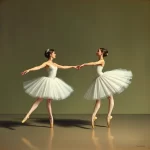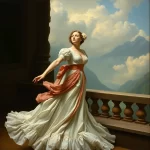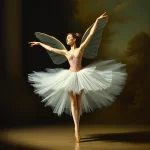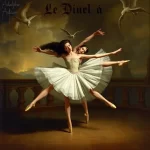Ballet: Pas de Quatre (Cesare Pugni, 1845)

Introduction
Ballet, an art form that combines dance, music, and storytelling, has produced numerous iconic works over the centuries. One such masterpiece is “Pas de Quatre,” a ballet composed by Cesare Pugni and choreographed by Jules Perrot. Premiered in 1845, this ballet is renowned for its elegance, technical brilliance, and the unique collaboration between some of the most celebrated ballerinas of the time. “Pas de Quatre” does not follow a traditional narrative but instead showcases the talents of its dancers through a series of solos and ensemble pieces, celebrating the art of ballet itself.
Historical Background
Creation and Development
“Pas de Quatre” was created during a period of significant evolution in the world of ballet. The mid-19th century was marked by the Romantic movement, which emphasized emotion, individualism, and the sublime. This era saw the rise of the ballerina as the central figure in ballet, with a focus on ethereal and expressive performances.
The inspiration behind “Pas de Quatre” was to bring together four of the most famous ballerinas of the time: Marie Taglioni, Carlotta Grisi, Fanny Cerrito, and Lucile Grahn. The idea was to create a ballet that would highlight their unique talents and styles, offering audiences a rare opportunity to see these stars perform together. Jules Perrot, a renowned choreographer, collaborated with composer Cesare Pugni to bring this vision to life. Their partnership resulted in a ballet that was both technically demanding and artistically exquisite.
Premiere and Reception
“Pas de Quatre” premiered on July 12, 1845, at Her Majesty’s Theatre in London. The performance was met with great enthusiasm from both critics and audiences. The ballet was praised for its innovative choreography, beautiful music, and the exceptional performances of the four leading ballerinas. The initial reception was overwhelmingly positive, and the ballet quickly became a sensation.
Notable early performances included revivals in major European cities, where the ballet continued to captivate audiences. The unique concept of bringing together four prima ballerinas in a single performance was a significant draw, and “Pas de Quatre” became a landmark in the history of ballet.
Synopsis of the Ballet
“Pas de Quatre” is a one-act ballet that does not follow a traditional narrative structure. Instead, it is a showcase of the talents of its four leading ballerinas. The ballet consists of a series of solos and ensemble pieces, each designed to highlight the unique strengths and styles of the dancers.
Key Moments
- Opening Ensemble: The ballet begins with an ensemble piece featuring all four ballerinas, setting the stage for the individual solos to come.
- Solos: Each ballerina performs a solo that showcases her unique style and technical prowess. These solos are the heart of the ballet, allowing each dancer to shine.
- Finale: The ballet concludes with a grand ensemble piece that brings all four ballerinas together, celebrating their collective talent and the art of ballet.
Musical Composition
Composer’s Role
Cesare Pugni, an Italian composer known for his work in ballet, played a crucial role in the creation of “Pas de Quatre.” Pugni’s music is characterized by its melodic beauty and rhythmic complexity, providing the perfect accompaniment to Perrot’s choreography. His score for “Pas de Quatre” is both elegant and expressive, enhancing the emotional impact of the dancers’ performances.
Musical Themes and Motifs
The music of “Pas de Quatre” features several recurring themes and motifs that help to unify the ballet. Pugni’s use of leitmotifs allows the music to reflect the individual personalities and styles of the ballerinas. The score is carefully crafted to enhance the narrative and emotional arc of the ballet, providing a rich musical backdrop for the dancers.
Famous Recordings and Performances
Over the years, “Pas de Quatre” has been recorded and performed by numerous ballet companies around the world. Some of the most iconic recordings include performances by the Royal Ballet and the Bolshoi Ballet, both of which have brought their own unique interpretations to the work. These recordings have helped to preserve the legacy of “Pas de Quatre” and introduce it to new generations of ballet enthusiasts.
Choreography and Dance
Choreographer’s Vision
Jules Perrot’s vision for “Pas de Quatre” was to create a ballet that would highlight the individual talents of its four leading ballerinas while also celebrating the art of ballet as a whole. Perrot’s choreography is known for its technical brilliance and expressive quality, combining intricate footwork with graceful movements. His innovative approach to choreography helped to elevate “Pas de Quatre” to a new level of artistic excellence.
Signature Dance Numbers
- Opening Ensemble: This piece sets the tone for the ballet, introducing the four ballerinas and showcasing their collective talent.
- Individual Solos: Each ballerina performs a solo that highlights her unique style and technical abilities. These solos are the centerpiece of the ballet, allowing each dancer to shine.
- Finale: The ballet concludes with a grand ensemble piece that brings all four ballerinas together, celebrating their collective talent and the art of ballet.
Notable Interpretations
Over the years, “Pas de Quatre” has been interpreted and adapted by various ballet companies around the world. Each production brings its own unique perspective to the work, reflecting the evolving nature of ballet as an art form. Notable interpretations include performances by the Royal Ballet, the Bolshoi Ballet, and the American Ballet Theatre, each of which has brought its own unique style and vision to the ballet.
Characters and Roles
Main Characters
The main characters in “Pas de Quatre” are the four leading ballerinas, each of whom brings her own unique style and personality to the ballet. These characters are not defined by a traditional narrative but are instead celebrated for their individual talents and contributions to the art of ballet.
Supporting Characters
As a one-act ballet focused on the performances of the four leading ballerinas, “Pas de Quatre” does not feature traditional supporting characters. The emphasis is on the individual and collective talents of the main dancers.
Famous Dancers
Over the years, many famous dancers have portrayed the roles in “Pas de Quatre.” Some of the most notable include Margot Fonteyn, Alicia Markova, and Natalia Makarova, each of whom brought her own unique style and interpretation to the ballet. These dancers have helped to preserve the legacy of “Pas de Quatre” and introduce it to new generations of ballet enthusiasts.
Cultural and Artistic Impact
Influence on Ballet and Dance
“Pas de Quatre” has had a significant influence on the world of ballet and dance. Its innovative choreography and focus on the individual talents of its dancers helped to elevate the art of ballet to new heights. The ballet has inspired countless choreographers and dancers, contributing to the development of ballet as an art form.
Cultural Significance
“Pas de Quatre” holds a special place in popular culture and the history of ballet. Its unique concept of bringing together four prima ballerinas in a single performance has made it a landmark in the world of dance. The ballet has been referenced in literature, film, and other media, further cementing its cultural significance.
Legacy and Revivals
Over the years, “Pas de Quatre” has been revived and reinterpreted by numerous ballet companies around the world. These revivals have helped to preserve the legacy of the ballet and introduce it to new generations of audiences. The ballet continues to be performed and celebrated today, a testament to its enduring appeal and significance.
Iconic Productions
Historic Productions
Some of the most famous historical productions of “Pas de Quatre” include performances by the Royal Ballet and the Bolshoi Ballet. These productions featured some of the most celebrated dancers of their time and helped to establish “Pas de Quatre” as a landmark in the history of ballet.
Contemporary Productions
Recent productions of “Pas de Quatre” have brought new interpretations and perspectives to the ballet. Contemporary ballet companies have explored innovative approaches to choreography, set design, and performance, reflecting the evolving nature of ballet as an art form.
Production Design
The production design of “Pas de Quatre” has evolved over the years, with various interpretations of set, costume, and lighting design. Early productions featured elaborate costumes and sets that reflected the Romantic era’s emphasis on beauty and elegance. Contemporary productions have experimented with minimalist designs and modern aesthetics, offering new interpretations of the ballet’s visual elements.
Critical Reception and Reviews
Initial Critical Response
At the time of its premiere, “Pas de Quatre” received overwhelmingly positive reviews from critics. The ballet was praised for its innovative choreography, beautiful music, and exceptional performances by the four leading ballerinas. Critics lauded the ballet’s ability to showcase the individual talents of its dancers while also celebrating the art of ballet as a whole.
Modern Reviews
Contemporary critics and audiences continue to hold “Pas de Quatre” in high regard. The ballet is celebrated for its historical significance, artistic excellence, and enduring appeal. Modern reviews often highlight the ballet’s innovative choreography and the exceptional performances of its dancers, emphasizing why “Pas de Quatre” remains relevant and popular today.
Fun Facts and Trivia
Behind-the-Scenes Stories
One interesting anecdote from the original production of “Pas de Quatre” involves the rivalry between the four leading ballerinas. Despite their professional collaboration, there were tensions and competition among them, adding an intriguing layer to the ballet’s history.
Notable Performers
Over the years, many famous dancers have performed in “Pas de Quatre,” including Margot Fonteyn, Alicia Markova, and Natalia Makarova. These dancers have brought their own unique styles and interpretations to the ballet, contributing to its enduring legacy.
Trivia
- “Pas de Quatre” was originally intended to be performed only once, but its success led to numerous revivals and performances.
- The ballet’s unique concept of featuring four prima ballerinas in a single performance was unprecedented at the time.
- Cesare Pugni, the composer of “Pas de Quatre,” was one of the most prolific ballet composers of the 19th century, with over 300 ballets to his name.
Conclusion
Summary of the Ballet’s Importance
“Pas de Quatre” is a landmark in the history of ballet, celebrated for its innovative choreography, beautiful music, and exceptional performances. The ballet’s unique concept of bringing together four prima ballerinas in a single performance has made it a significant work in the world of dance.
Final Thoughts
“Pas de Quatre” continues to captivate audiences with its elegance, technical brilliance, and artistic excellence. Its enduring appeal and significance in the history of ballet make it a must-see for any ballet enthusiast. Whether you are a seasoned ballet aficionado or a newcomer to the art form, “Pas de Quatre” offers a unique and unforgettable experience.
FAQ
What is the central theme of this ballet?
The central theme of “Pas de Quatre” is the celebration of ballet as an art form, showcasing the individual talents and styles of its four leading ballerinas.
Who are the main characters in this ballet?
The main characters are the four leading ballerinas: Marie Taglioni, Carlotta Grisi, Fanny Cerrito, and Lucile Grahn.
What is the most famous dance number in this ballet?
The most famous dance numbers are the individual solos performed by each of the four ballerinas, showcasing their unique styles and technical abilities.
How long does a typical performance of this ballet last?
A typical performance of “Pas de Quatre” lasts approximately 30 minutes, as it is a one-act ballet.
Are there any modern adaptations of this ballet?
Yes, there have been numerous modern adaptations and revivals of “Pas de Quatre” by various ballet companies around the world, each bringing its own unique interpretation to the work.
Why is this ballet considered important in the history of dance?
“Pas de Quatre” is considered important in the history of dance for its innovative choreography, beautiful music, and the unique concept of featuring four prima ballerinas in a single performance. It has had a significant influence on the development of ballet as an art form and continues to be celebrated and performed today.





